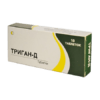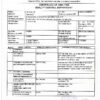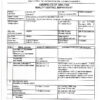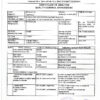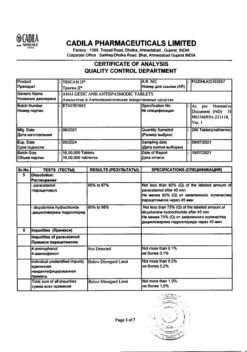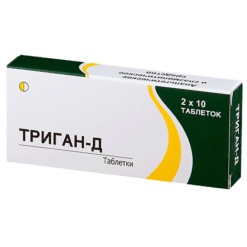No products in the cart.
Trigan-D, tablets 10 pcs
€4.45 €3.96
Description
Pharmacotherapeutic group: analgesic (analgesic non-narcotic agent + antispasmodic agent).
ATC code [N02BE51]
Pharmacodynamics.
The paracetamol contained in the drug has analgesic, antipyretic and mild anti-inflammatory effects.
The mechanism of action is related to moderate inhibition of cyclooxygenase-1 and, to a lesser degree, of cyclooxygenase-2 in peripheral tissues and central nervous system, which results in inhibition of prostaglandin biosynthesis – modulators of pain sensitivity, thermoregulation and inflammation.
The second component is dicycloverine hydrochloride, a tertiary amine which has relatively weak non-selective m-cholinoblocking and direct myotropic spasmolytic effect on the smooth muscles of internal organs.
In therapeutic doses, it causes effective relaxation of smooth muscles, which is not accompanied by the side effects typical of atropine.
The combined action of the two components of Trigan-D provides relaxation of the spasmed smooth muscle of the internal organs and reduction of pain sensations.
Pharmacokinetics. The drug is well absorbed in the gastrointestinal tract. Maximal concentration in blood plasma is reached after 60-90 min. The volume of distribution is 3.65 l/kg.
Paracetamol is metabolized in the liver to form several metabolites, one of which – N-acetyl-benzoquinonimine – under certain conditions (drug overdose, lack of glutathione in the liver) may have a damaging effect on the liver and kidneys.
About 80% of the drug is excreted with urine and in small amounts with feces.
Indications
Indications
Spasm of smooth muscles of internal organs – intestinal, hepatic and renal colic, algodysmenorrhea;
Headache, toothache, migraine pain, neuralgia, myalgia;
Active ingredient
Active ingredient
Composition
Composition
One tablet contains:
The active ingredients:
Paracetamol – 500 mg
dicycloverine hydrochloride – 20 mg
Excipients:
Sodium carboxymethyl starch – 25.0 mg
Corn starch – 15.0 mg
Microcrystalline cellulose – 17.5 mg
Povidone K-30 – 4.5 mg
Colloidal silica (aerosil) – 3.0 mg
Magnesium stearate – 5.0 mg
How to take, the dosage
How to take, the dosage
It is used orally in adults and children over 15 years old, 1 tablet 2-3 times a day. The maximum single dose for adults is 2 tablets, the daily dose is 4 tablets.
The duration of use without physician’s consultation is not more than 5 days if prescribed as an analgesic and 3 days if prescribed as an antipyretic.
In prolonged use of the drug it is necessary to control peripheral blood count and liver function.
Do not exceed the daily dose; its increase or longer treatment is possible only under the supervision of a physician, because overdosing of the drug may cause hepatic failure.
Do not exceed the daily dose.
Interaction
Interaction
The action of dicycloverine is enhanced by amantadine, class I antiarrhythmic drugs, antipsychotics, benzodiazepines, MAO inhibitors, narcotic analgesics, nitrates and nitrites, sympathomimetic drugs, tricyclic antidepressants.
Dicycloverine increases the blood concentration of digoxin (due to delayed gastric emptying).
Stimulants of microsomal oxidation in the liver (phenytoin, ethanol, barbiturates, rifampicin, phenylbutazone, tricyclic antidepressants) increase production of hydroxylated active metabolites, which leads to possible severe intoxication in small overdoses of paracetamol.
Adrenostimulants and other drugs with anticholinergic effects increase the risk of side effects. Microsomal oxidation inhibitors (cimetidine) reduce the risk of hepatotoxic effects.
Decreases the effectiveness of uricosuric drugs.
Paracetamol increases the effectiveness of indirect anticoagulants.
Special Instructions
Special Instructions
The drug should be used with caution and under medical supervision in patients with impaired hepatic or renal function, simultaneously with other anti-inflammatory and analgesic drugs, as well as with anticoagulants and drugs affecting the central nervous system.
When taking metoclopramide, domperidone or colestiramine, a physician should also be consulted.
Paracetamol distorts laboratory values in the quantification of plasma uric acid and glucose.
In order to avoid toxic liver damage, paracetamol should not be combined with the intake of alcoholic beverages, and should not be taken by persons prone to chronic alcohol consumption. The risk of liver damage increases in patients with alcoholic hepatosis.
When using the drug, one should refrain from potentially hazardous activities requiring increased concentration and rapid psychomotor reactions (driving, etc.).
During long-term treatment it is necessary to monitor the peripheral blood picture and the functional state of the liver.
.
Contraindications
Contraindications
High sensitivity to paracetamol and dicycloverine, obstructive diseases of the intestine, biliary and urinary tract, gastric and 12 duodenal ulcer (acute phase), reflux esophagitis, hypovolemic shock, myasthenia gravis, pregnancy, lactation. Childhood (under 15 years).
Side effects
Side effects
Gastrointestinal tract: dry mouth, loss of taste, decreased appetite, epigastric pain, constipation, increased activity of “liver” enzymes, usually without development of jaundice, hepatonecrosis (dose-dependent effect).
Allergic reactions: skin rash, pruritus, urticaria, Quincke’s edema, erythema multiforme (including Stevens-Johnson syndrome), toxic epidermal necrolysis (Lyell syndrome).
Central nervous system disorders (usually developed with high doses): drowsiness, dizziness, psychomotor agitation and disorientation, hallucinations (frequency unknown).
Endocrine system disorders: hypoglycemia, up to hypoglycemic coma.
Hematopoietic disorders: anemia, methemoglobinemia (cyanosis, shortness of breath, heart pain), hemolytic anemia (especially in patients with gluco-6-phosphate dehydrogenase deficiency).
Urogenital system disorders: pyuria, urinary retention, interstitial nephritis, papillary necrosis.
Visual organs: mydriasis, blurred vision, accommodation paralysis, increased intraocular pressure.
Decreased potency.
Overdose
Overdose
Symptoms: tachycardia, tachypnoea, fever, agitation, convulsions, epigastric pain, decreased appetite, anemia, thrombocytopenia, hemolytic anemia, aplastic anemia, methemoglobinemia, pancytopenia, nephrotoxicity (papillary necrosis), hepatonecrosis.
Treatment: discontinue the drug, gastric lavage, prescribe adsorbents, administer agents that increase glutathione formation (intravenous acetylcysteine) and enhance conjugation reactions (oral methionine).
Additional information
| Shelf life | 3 years. |
|---|---|
| Conditions of storage | Store in a light-protected place at a temperature not exceeding 25 °С. Keep out of reach of children! |
| Manufacturer | Kadila Pharmaceuticals Ltd, India |
| Medication form | pills |
| Brand | Kadila Pharmaceuticals Ltd |
Other forms…
Related products
Buy Trigan-D, tablets 10 pcs with delivery to USA, UK, Europe and over 120 other countries.





